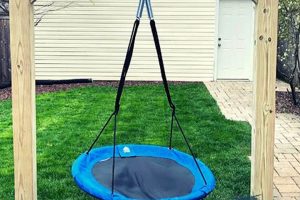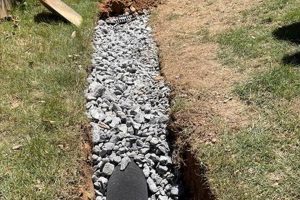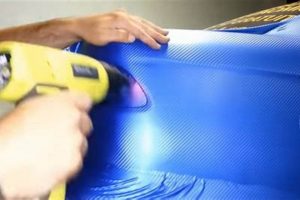A self-constructed barbecue apparatus utilizing charcoal as its primary heat source represents an avenue for personalized outdoor cooking. This type of project involves the design and physical creation of a grilling unit, often from readily available materials such as metal drums, concrete blocks, or repurposed containers. The resulting appliance offers a direct flame environment for searing and smoking various foods. As an example, a discarded steel barrel can be cut and modified with grates and ventilation to function as a fully operational barbecue.
The construction of such a device can offer several advantages. It provides a cost-effective alternative to commercially manufactured grills, particularly for individuals with welding or metalworking skills. Furthermore, it facilitates customization, allowing builders to tailor the size, shape, and features to their specific needs and preferences. Historically, homemade barbecues have been a common practice, especially in communities where access to manufactured goods was limited or where resourcefulness was highly valued.
The subsequent sections will explore various design considerations, material selection guidelines, and safety precautions necessary for successfully building a functional and safe charcoal-fueled cooking apparatus. Focus will be placed on ensuring proper ventilation, heat distribution, and structural integrity to maximize the performance and longevity of the finished product.
Construction Considerations
The following are crucial aspects to consider when embarking on the construction of a charcoal-fueled grilling apparatus. Addressing these points ensures safety, functionality, and longevity of the device.
Tip 1: Material Selection: Prioritize heat-resistant and food-safe materials. Stainless steel, heavy-gauge carbon steel, and fire bricks are suitable choices. Avoid galvanized metals due to potential toxic fumes when heated.
Tip 2: Ventilation Design: Incorporate adjustable air vents at both the bottom and top of the grill. This regulates airflow, controlling the combustion rate of the charcoal and the overall cooking temperature.
Tip 3: Grate Material: The cooking grate must be durable and non-reactive. Stainless steel or porcelain-coated cast iron are recommended. Ensure adequate spacing to prevent food from falling through.
Tip 4: Structural Stability: The base or supporting structure should be robust enough to support the weight of the grill and its contents. Welded joints or securely bolted connections are necessary.
Tip 5: Heat Shielding: If constructing a grill near combustible surfaces, implement heat shields to prevent fire hazards. Reflective metal barriers or insulation can mitigate radiant heat transfer.
Tip 6: Ash Removal System: Design an accessible ash collection system for easy cleaning. A removable tray or dedicated ash access door simplifies maintenance and prevents ash buildup from impeding airflow.
Tip 7: Temperature Monitoring: Consider integrating a thermometer into the grill lid. This provides accurate temperature readings, allowing for precise control during cooking.
Adherence to these guidelines promotes a safe and efficient grilling experience. Thoughtful material selection, robust construction, and effective temperature control are fundamental to success.
With careful planning and execution, a personalized grilling apparatus can provide years of reliable service. The subsequent section offers a comprehensive summary of this construction process.
1. Material Safety
Material safety constitutes a critical component in the creation of a charcoal-fueled grilling apparatus. The selection of inappropriate materials can present immediate and long-term hazards, potentially compromising the health of individuals consuming food prepared on the apparatus, as well as the structural integrity of the device itself. For instance, utilizing galvanized steel, which contains a zinc coating, introduces the risk of zinc oxide fume emission when exposed to high temperatures. Inhalation of these fumes can cause metal fume fever, a condition characterized by flu-like symptoms. The presence of lead-based paints or coatings also poses a threat, as these substances can leach into food during the cooking process, leading to lead poisoning. Food-grade stainless steel, on the other hand, offers a safe and durable alternative, as it is resistant to corrosion and does not release harmful substances when heated.
The importance of material selection extends beyond direct health concerns. Utilizing materials unsuitable for high-temperature environments can compromise the structural integrity of the barbecue. Thin or low-quality metals may warp or buckle under intense heat, potentially leading to the collapse of the structure. This can result in injury from falling components or uncontrolled fires. Furthermore, the degradation of materials can introduce particulate matter into the cooking environment, affecting the flavor and quality of the prepared food. Repurposed materials, while appealing for their cost-effectiveness and environmental friendliness, require careful scrutiny to ensure they are free from contaminants and capable of withstanding the extreme conditions associated with charcoal grilling. An example is the use of a repurposed propane tank; it must be thoroughly cleaned and purged to eliminate any residual propane, which is extremely flammable and explosive.
In conclusion, prioritizing material safety is not merely a best practice but a fundamental requirement for constructing a charcoal grilling apparatus. The selection of appropriate materials mitigates health risks associated with toxic emissions and food contamination, while also ensuring the structural integrity and longevity of the device. A lack of attention to this critical aspect can have severe consequences, ranging from minor health ailments to catastrophic structural failures. Therefore, a thorough understanding of material properties and potential hazards is paramount to responsible and safe barbecue construction.
2. Airflow Control
Airflow control is a fundamental design element in the creation of a charcoal-fueled grilling apparatus. Precise regulation of air intake and exhaust directly impacts the combustion rate of the charcoal and, consequently, the internal cooking temperature. Effective management of airflow is therefore essential for achieving desired cooking results and maintaining a safe operating environment.
- Combustion Rate Regulation
The rate at which charcoal burns is directly proportional to the amount of oxygen available. Airflow control mechanisms, such as adjustable vents located near the charcoal bed, modulate the oxygen supply. Reducing airflow restricts combustion, lowering the temperature; conversely, increasing airflow accelerates combustion, raising the temperature. This principle is critical fo
r maintaining stable temperatures during long cooking sessions, such as smoking. - Temperature Gradients and Distribution
Improper airflow can lead to uneven heat distribution within the grill. Insufficient airflow to certain areas results in cooler zones, while excessive airflow to others creates hot spots. Strategically positioned vents and baffles can mitigate these issues by promoting uniform heat circulation. In a horizontally oriented grill, for example, vents on opposite ends of the charcoal bed can ensure consistent temperatures across the cooking surface.
- Smoke Management
Airflow not only affects temperature but also influences the concentration and flow of smoke. For barbecue applications, where smoky flavors are desired, controlling airflow is essential for optimizing smoke exposure. Restricting the exhaust vent can increase smoke density, while opening it allows for ventilation, preventing an overly smoky flavor. The position of the exhaust vent also dictates the direction of smoke flow across the food.
- Safety Considerations
Uncontrolled airflow can pose significant safety risks. Excessive airflow can lead to rapid and intense combustion, creating dangerously high temperatures and the potential for flare-ups. Conversely, insufficient airflow can result in incomplete combustion, producing carbon monoxide, a colorless and odorless gas. Properly designed and operated airflow controls are therefore critical for preventing hazardous conditions.
These interconnected facets of airflow control underscore its importance in DIY charcoal grill construction. By carefully considering these principles, builders can create efficient, versatile, and safe cooking apparatuses that allow for precise temperature management and optimal flavor development.
3. Structural Integrity
Structural integrity, in the context of a self-constructed charcoal grill, represents the capacity of the entire unit to withstand the forces and stresses imposed by its intended use, environmental factors, and the weight of its components and fuel. A failure in structural integrity can lead to catastrophic events, ranging from a simple collapse rendering the grill unusable to a significant safety hazard involving hot coals and potentially serious burns. The cause of such failure often stems from inadequate material selection, improper welding techniques, or flawed design concepts that do not account for thermal expansion and contraction. For instance, a grill constructed with insufficient bracing might buckle under the weight of a full load of charcoal and cooking grates, especially when exposed to high temperatures, resulting in a dangerous spill of hot materials. The importance of structural integrity is paramount; it directly affects the safety of the user and bystanders, as well as the lifespan and usability of the grilling apparatus. A poorly designed and constructed grill lacking adequate structural support poses a tangible threat to its users.
Practical significance can be illustrated through several design considerations. The use of thicker gauge steel for the firebox can prevent warping and cracking due to prolonged exposure to high temperatures. Incorporating reinforced welds at stress points, such as leg connections and grate supports, can prevent fatigue and eventual failure. Designing for thermal expansion by allowing for small gaps in joints can prevent buckling and distortion as the metal heats and cools. Furthermore, considering the weight distribution of the grill when loaded with charcoal and food is crucial for ensuring stability and preventing tipping. For example, a tall, narrow grill design is inherently less stable than a wider, lower design, necessitating a heavier base or additional support structures to maintain equilibrium. Selecting materials with appropriate strength and heat resistance, coupled with sound engineering principles, translates to a safe and reliable grilling experience.
In summary, structural integrity is not merely an aesthetic consideration but a fundamental requirement for any self-built charcoal grill. It dictates the safety, durability, and overall functionality of the appliance. Addressing potential weaknesses through careful design, appropriate material selection, and robust construction techniques is essential. Overlooking these aspects can lead to hazardous conditions and premature failure, negating the cost savings and personalization benefits of a do-it-yourself approach. Therefore, a thorough understanding of structural principles and their application is crucial for a successful and safe outcome.
4. Grate Selection
The choice of cooking grate is a critical factor in the design and performance of a charcoal-fueled grill. It directly impacts food safety, heat distribution, and ease of use. The selection process should carefully consider material properties, construction methods, and suitability for the intended grilling style.
- Material Composition and Food Safety
The grate material must be food-safe and resistant to corrosion. Common materials include stainless steel, porcelain-coated cast iron, and bare cast iron. Stainless steel offers excellent corrosion resistance and ease of cleaning but may not retain heat as effectively as cast iron. Porcelain-coated cast iron provides good heat retention and a non-stick surface but is susceptible to chipping, which can expose the underlying cast iron to rust. Bare cast iron offers superior heat retention and searing capabilities but requires regular seasoning to prevent rust and food from sticking. The selection should align with the user’s maintenance capabilities and food safety priorities.
- Grate Design and Heat Distribution
The spacing and configuration of the grate bars influence heat distribution across the cooking surface. Closely spaced bars provide more even heat distribution but can restrict airflow, potentially affecting charcoal combustion. Wider spacing allows for better airflow but may result in uneven cooking due to hot spots. The design should balance the need for even heat distribution with adequate airflow to maintain consistent temperatures. Grates with variable bar spacing can offer a compromise, providing both even heat and good airflow.
- Construction and Durability
The method of construction and the quality of materials determine the grate’s durability and lifespan. Welded or cast grates offer greater strength and resistance to warping compared to stamped or expanded metal grates. The gauge of the material also affects durability; thicker materials are more resistant to deformation under heat and weight. For a self-built charcoal grill, the grate must be able to withstand repeated heating and cooling cycles without degradation or failure. Careful consideration should be given to the load-bearing capacity and resistance to corrosion based on the expected usage and environmental conditions.
These selection facets directly impact a grilling apparatus capabilities. In summary, successful construction requires a grate of the appropriate material, construction, and safety standards.
5. Ash Management
Effectiv
e ash management is an integral design consideration for any charcoal-fueled grilling apparatus. The accumulation of ash, a byproduct of charcoal combustion, can impede airflow, reduce heating efficiency, and, in extreme cases, pose a fire hazard. A well-designed ash management system ensures efficient operation, ease of maintenance, and enhanced safety of the grilling unit.
- Airflow Obstruction Mitigation
As charcoal burns, it produces ash, which can accumulate and block the air vents located at the base of the grill. This obstruction reduces the oxygen supply to the burning charcoal, diminishing its combustion rate and lowering the overall temperature. A dedicated ash removal system, such as a removable ash pan or an ash drawer, facilitates periodic removal of accumulated ash, maintaining optimal airflow and consistent temperatures. Neglecting ash removal can lead to inconsistent cooking and the need for frequent relighting of the charcoal.
- Corrosion Prevention
Ash contains corrosive compounds that, when in prolonged contact with metal surfaces, can accelerate rust formation and material degradation. Allowing ash to accumulate within the grilling unit, particularly in areas prone to moisture, increases the risk of corrosion, shortening the lifespan of the apparatus. An effective ash management system minimizes contact between ash and the grill’s structure, reducing the likelihood of corrosion and extending the unit’s operational life. Properly coating metal with heat-resistant paint also assists.
- Fire Hazard Reduction
While seemingly inert, accumulated ash can retain embers for extended periods, posing a potential fire hazard if improperly handled. Disposing of hot ash in combustible containers or near flammable materials can lead to unintended fires. A designated ash collection system, such as a metal ash can with a tight-fitting lid, allows for safe containment and cooling of ash before disposal. Furthermore, regular removal of ash from the grill reduces the risk of smoldering embers igniting nearby materials.
- Cleaning and Maintenance Efficiency
An easily accessible and removable ash collection system simplifies the cleaning and maintenance process. Without such a system, removing ash can be a messy and time-consuming task, often requiring the use of specialized tools and creating a significant amount of airborne dust. A well-designed system allows for quick and clean removal of ash, minimizing disruption to the cooking process and encouraging regular maintenance, which contributes to the overall longevity and performance of the grilling unit.
In conclusion, effective ash management is not merely a matter of convenience but a critical aspect of designing and maintaining a safe and efficient charcoal-fueled grilling apparatus. The implementation of a dedicated ash collection system mitigates airflow obstruction, prevents corrosion, reduces fire hazards, and simplifies cleaning, contributing to a more enjoyable and safer grilling experience.
6. Heat Distribution
Heat distribution represents a critical performance factor in any charcoal-fueled grilling apparatus, profoundly influencing cooking uniformity, fuel efficiency, and overall culinary outcome. In the context of a self-constructed barbecue, achieving consistent and controllable heat distribution becomes a significant design and operational challenge. Uneven temperatures lead to hot spots, scorching, and inconsistent doneness, detracting from the grilling experience.
- Firebox Design and Configuration
The geometry and construction of the firebox significantly influence heat radiation and convection patterns. A shallow, wide firebox promotes more even heat distribution across the cooking surface compared to a deep, narrow design. Furthermore, strategically placed baffles or diffusers within the firebox can redirect heat flow, mitigating hot spots and ensuring a more uniform temperature profile. A smoker box is another example of even distribution.
- Ventilation Placement and Control
The location and adjustability of air vents directly impact the charcoal combustion rate and the resulting heat distribution. Inadequate ventilation can lead to smoldering charcoal and low temperatures, while excessive ventilation can create localized hot zones. Precisely positioned and controllable vents allow for fine-tuning of airflow, enabling the user to maintain a consistent temperature across the cooking surface and achieve desired grilling or smoking results. The user can control where most of the heat is coming from.
- Material Conductivity and Thickness
The thermal conductivity and thickness of the materials used in the grill’s construction affect the transfer and dissipation of heat. Materials with high thermal conductivity, such as steel, distribute heat more efficiently than materials with low conductivity, such as ceramic. The thickness of the metal also plays a role; thicker metal retains heat better and moderates temperature fluctuations, contributing to more consistent heat distribution. This plays a factor for the longevity of the DYI charcoal grill.
- Charcoal Arrangement and Management
The method of arranging the charcoal and managing its distribution during cooking directly impacts heat distribution. Evenly spreading the charcoal across the fire grate provides a consistent heat source, while concentrating it in specific areas creates targeted hot zones for searing. Techniques such as the snake method or minion method, commonly used in smoking, involve arranging the charcoal in a specific pattern to achieve a slow, even burn and maintain a consistent temperature over extended periods. This is often utilized for smoking.
Mastering heat distribution is essential for maximizing the potential of a creation. By paying careful attention to firebox design, ventilation, material properties, and charcoal management, builders can overcome the inherent challenges of DIY construction and achieve consistent, controllable heat for optimal grilling and smoking results.
Frequently Asked Questions
The following questions address common inquiries regarding the construction and utilization of self-built charcoal grilling apparatuses. These responses aim to provide clarity and guidance based on established principles of engineering, safety, and culinary practice.
Question 1: What is the most significant safety concern when building a charcoal grill?
The selection of materials constitutes the most critical safety consideration. Avoidance of galvanized metals is paramount due to the emission of toxic zinc oxide fumes when heated. Furthermore, repurposed containers must be thoroughly cleaned and verified as food-safe prior to construction. Ignition hazards must also be taken into consideration.
Question 2: How can optimal airflow be achieved in a homemade grill?
Effective airflow is achieved through the strategic placement of adjustable vents. Vents located near the charcoal bed provide oxygen for combustion, while vents near the top of the grill regulate smoke and heat exhaust. The size and adjustability of these vents directly influence temperature control and combustion efficiency.
Question 3: What type of welding is recommended for grill construction?
Metal Inert Gas (MIG) welding is generally recommended for its ease of use and ability to create strong, durable welds on various types of steel. Shielded Metal Arc Welding (SMAW), also
known as stick welding, is also acceptable but requires greater skill to achieve clean and consistent results.
Question 4: How can one minimize the risk of rust formation on a charcoal grill?
Rust formation can be minimized by selecting corrosion-resistant materials such as stainless steel. For carbon steel grills, regular cleaning, the application of high-temperature paint, and the maintenance of a seasoned cooking grate are crucial for preventing oxidation.
Question 5: What is the ideal height for a cooking grate above the charcoal?
The optimal distance between the cooking grate and the charcoal bed depends on the desired cooking temperature and method. A distance of 4-6 inches is generally suitable for searing, while a distance of 8-12 inches is more appropriate for smoking and slow cooking. Adjustments may be necessary based on charcoal quantity and ventilation settings.
Question 6: How does the shape of the grill impact cooking performance?
The shape of the grill influences heat distribution and airflow patterns. Cylindrical or barrel-shaped grills tend to promote more even heat circulation than rectangular grills. Furthermore, the size and depth of the cooking chamber affect temperature stability and the capacity for indirect cooking methods.
These FAQs provide a foundation for understanding the key considerations involved in self-constructing a charcoal grill. However, comprehensive knowledge and adherence to safety guidelines are imperative for a successful and safe outcome.
The next section will delve into specific design plans and construction techniques for building various types of charcoal grilling apparatuses.
DIY Charcoal Grill
The preceding exploration has illuminated various facets of self-constructed charcoal grilling apparatuses, emphasizing safety protocols, material considerations, and the fundamental principles of heat management. The construction endeavor necessitates a thorough understanding of thermodynamics, material science, and fabrication techniques to ensure structural integrity and operational efficiency. Furthermore, adherence to established safety guidelines is paramount to mitigate potential hazards associated with high-temperature environments and combustion byproducts.
The decision to embark on a project is contingent upon a comprehensive assessment of skill level, available resources, and the acceptance of inherent risks. While the potential for customization and cost savings exists, the responsible and informed execution of these construction techniques remains paramount. The successful implementation of these principles ensures a functional, durable, and, most importantly, safe charcoal grilling experience.







